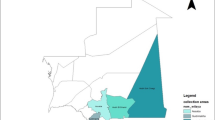Abstract
Inter-Simple Sequence Repeat (ISSR) and Randomly Amplified Polymorphic DNA (RAPD) markers were used to analyze genetic distance among H. vulgare subsp. spontaneum populations from west Turkey. Fifty-five RAPD and 10 ISSR primers were used to detect variation among sample. A total of 55 polymorphic loci were found using 65 primers. Two distinct cluster groups were clearly established among populations. The minimum variation was detected between Pinarbasi and Bornova (GD = 0.192) populations and the maximum was found between Icmeler and Aydin populations (GD = 0.926). As two dominant markers, RAPD and ISSRs are effective and promising marker systems for detecting genetic variation.
Similar content being viewed by others
References
Bjornstad A., Demisse A., Killian A. and Kleinhofs A. 1997. The distinctness and diversity of Ethiopian barleys. Theor. Appl. Genet. 94: 514-521.
Bustos A., Casanova De. C., Soler C. and Jouve N. 1998. RAPD variation in wild populations of four species of the genus Hordeum (Poaceae). Theor. Appl. Genet. 96: 101-111.
Castagana R., Gnocchi S., Perenzin M. and Heun M. 1997. Genetic variability of the wild diploid wheat Triticum urartu revealed by RFLP and RAPD markers. Theor. Appl. Genet. 94: 424-430.
Dawson I.K., Chalmers K.J., Waugh R. and Powell W. 1993. Detection and analysis of genetic variation in Hordeum spon-taneum populations from Israel using RAPD markers. Mol. Eco. 2: 151-159.
Doyle J.J. and Doyle J.L. 1990. Isolation of plant DNA from fresh tissue. Focus 12: 13-14.
Fahima T., Sun G.L., Beharav A., Krugman T., Beilas A. and Nevo E. 1999. RAPD polymorphism of wild emmer wheat populations, Triticum dicoccoides, in Israel. Theor. Appl. Genet. 98: 434-447.
Harlan J.R. and Zohary D. 1966. Distribution of wild wheat and barley. Science 153: 1074-1080.
Jaccard P. 1908. Nouvelles recherchers sur la distribution florale. Bull. Vaud. Soc. Nat. 44: 233-270.
Martin J.M., Blake T.K. and Hochett E.A. 1991. Diversity among North American spring barley culticars based on coefficients of varipercentage. Crop Sci. 31: 1131-1137.
Nevo E. 1992. Origin, evolution, population genetics and resources for breeding of wild barley, Hordeum spontaneum, in the fertile crescent. In: Shewrey P.R. (ed.), Barley. Genetics, Biochemistry, Molecular Biology. CAB International,Wallingford, pp. 19-43.
Nevo E., Zohary D., Brown A.H.D. and Haber M. 1979. Genetic samdiversity and environmental associations of wild barley, Hor-deum spontaneum, in Israel. Evolution 33: 815-833.
Nevo E., Zohary D., Beiles A., Kaplan D. and Storch N. 1986. Genetic diversity and environmental associations of wild barley, Hordeum spontaneum, in Turkey. Genetica 68: 203-213.
Paran I., Gidoni D. and Jacobsohn R. 1997.Variation between and within broomrape (Orobanche) species revealed by RAPD markers. Heredity 78: 68-74.
Peterson L., Ostergard H. and Giese H. 1994. Genetic diversity among and cultivated barley as revealed by RFLP. Theor. Appl. Genet. 89: 676-681.
Qian W., Ge S. and Houng D-Y. 2001. Genetic variation within and among populations of a wild rice Oryza granulata from China detected by RAPD and ISSR markers. Theor. Appl. Genet. 102: 440-449.
Russel J.R., Fuller J.D., Macaulay M., Hatz B.G., Jahoor A., Powell W. et al. 1997. Direct comparison of levels of genetic variation among barley accessions detected by RFLPs, AFLPs, SSRs and RAPDs. Theor. Appl. Genet. 95: 714-722.SAS, 1995. SAS User9s Guide, Version 6. SAS Institute, Cary, NC. US
Saghai-Maroof M.A., Soliman K.M., Jorgensen R.A. and Allard R.W. 1984. Ribosomal DNA spacer length polymorphism in barley. Mendelian inheritance, chromosomal location and population dynamics. Proc. Nat. Sci. 81: 8014-8018.
Thorman C.E., Ferreira M.E., Camargo L.E.A., Tivang J.G. and Osborn T.C. 1994. Comparison of RFLP and RAPD markers for estimating genetic relationship within and among cruciferous species. Theor. Appl. Genet. 88: 973-980.
Yang X. and Quiros C. 1993. Identification and classification of celery cultivars with RAPD markers. Theor. Appl. Genet. 86: 205-212.
Zang Q., Saghai-Maroof M.A. and Kleinhofs A. 1993. Comparative diversity analysis of RFLPs and isozymes within and among populations of Hordeum vulgare subsp. spontaneum. Genetics 134: 909-916.
Zohary D. 1969. The progenitors of wheat and barley in relation to domestication and agricultural dispersal in the old world. In: Ucho P.J. and Dembeleby G.W. (eds), Domestication and exploitation of plants and animals. Gerald Duckworth, London, pp. 47-66.
Author information
Authors and Affiliations
Rights and permissions
About this article
Cite this article
Tanyolac, B. Inter-simple sequence repeat (ISSR) and RAPD variation among wild barley (Hordeum. vulgare subsp. spontaneum) populations from west Turkey. Genetic Resources and Crop Evolution 50, 611–614 (2003). https://doi.org/10.1023/A:1024412814757
Issue Date:
DOI: https://doi.org/10.1023/A:1024412814757




